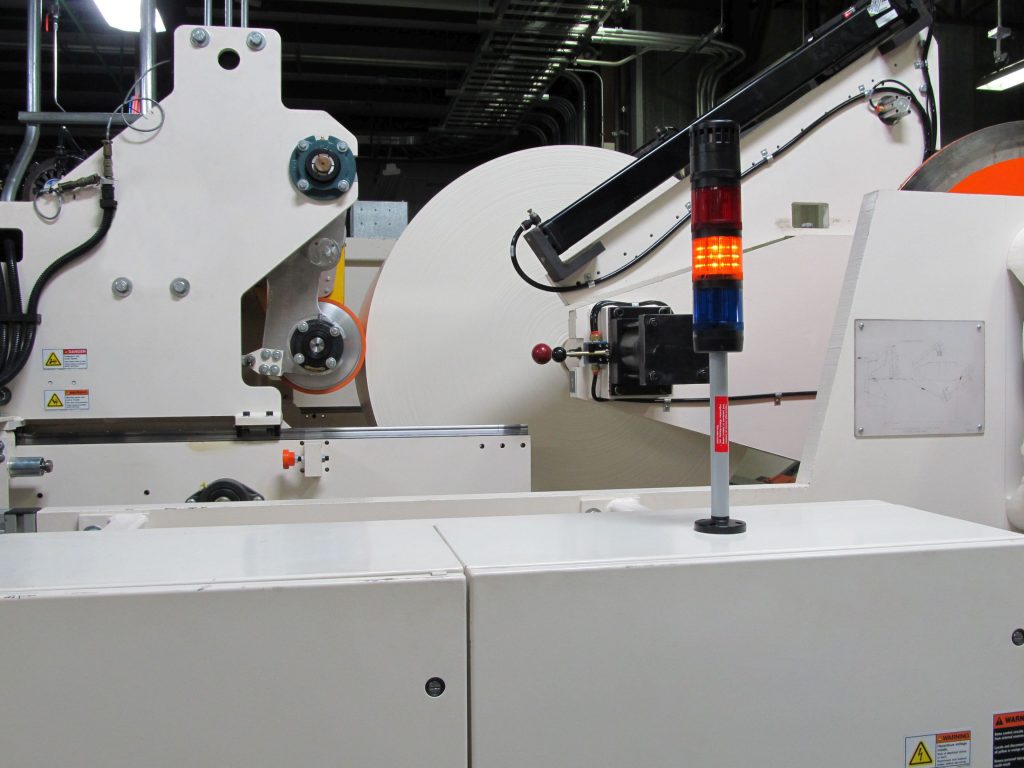
Welcome to the third blog of our winder series featuring the insight of our winding expert, Duane Smith.
The ability to wind good rolls on a consistent basis is a challenge for every winder operator. It is truly an art! However, by learning to handle webs with slight imperfections while producing quality rolls, you’ll improve operational efficiency and have happy customers. This blog covers the importance of roll density and application of “TNT” principles in winding good rolls.
The Importance of Roll Density
Achieving roll density or hardness in paramount to winding quality rolls for a quality process. Since there is no such thing as a perfect web, it is the winder operator’s responsibility to make sure slight imperfections do not stand out in appearance and cause process problems. Rolls wound too soft will have slippage of the layers when unwound at higher tensions, known as cinching. These rolls may also go “out-of-round” while winding or when handled or stored. Likewise, rolls wound too tight will exaggerate web defects. No web is perfectly flat or the same thickness from one side to the other. Typically, webs will have slight high and low areas in the cross-machine profile where the web is thicker or thinner. If rolls are wound too hard, the web will stretch over these thicker areas causing bumps or ridges. As the web is stretched over these ridges, it becomes deformed. This causes untensioned areas in the web known as “baggy areas” when the roll is unwound. There may also be moisture streaks where the web is higher in moisture in localized areas across the web. These moisture bands will cause web defects known as corrugations or rope marks. Ridges and corrugations cause issues such as poor registration on a printing line.
Some webs, either by their formation process or by their coating or web conditioning process, have cross-machine variations of thickness or moisture too severe to be wound without exaggerating these defects. To overcome this, these webs are moved back and forth before they are slit. This process, called oscillation, randomizes these localized defects across the wound rolls. On a slitter winder, the unwind is normally oscillated. Oscillation may be a constant speed, stop and constant speed back or a sine-type wave speed curve. What is important is that the oscillation speed is fast enough to randomize defects and slow enough that it does not strain or wrinkle the web and that the rolls after they have been slit are wound with straight edges. The rule of thumb for the maximum oscillation speed is 1-inch (50mm) per minute per 500 feet per minute winding speed. For best results, the oscillation speed should vary proportionally to the winding speed.
How to Achieve Roll Hardness
As a roll of web material winds, tension builds inside the roll, which is known as inwound tension or residual stress. If these stresses become greater as the roll is wound, then the inner wraps near the core will loosen. This is what causes the rolls to dish while winding or telescope when they are handled or being unwound by the customer. To prevent this, the rolls need to be wound tightly at the core with reduced tightness as the roll builds. The larger the finished rewind diameters, the more critical the roll hardness profile. Roll hardness is developed in different ways on different types of winders. But the basic principles of how to build roll hardness are always the same. To remember these principles, just recall that to consistently wind dynamite rolls you need T.N.T. (Tension, Nip, Torque).
Tension: The winding web tension
Nip: Nip of the pressure roll or drum
Torque: From the center drive or torque drum
Web Tension Principle of Winding
When winding elastic films, web tension is the dominant winding principle used to control roll hardness. The more tension pulled and the more stretch put on the web before winding, the harder the wound rolls will be. The winding web tension is often determined empirically. However, the maximum amount of web tension can also be determined by using 10 to 25 percent of the materials elastic limit. When only relying on tension to control roll density, it is important the winding tension is tapered smoothly as the roll diameter increases. The tension taper should be between 0 and 50 percent. A tension taper of 25 percent at full roll is common.
Nip Principle of Winding
When winding inelastic webs, nip is the dominant winding principle used to control roll hardness. Web tension is controlled to optimize the slitting and spreading operation. The nip controls the roll hardness by removing the boundary layer of air following the web into the winding roll. The rolling nip also introduces inwound tension to the roll. The harder the nip, the harder the winding roll will be. The challenge is to have sufficient nip to remove the air for winding hard, straight rolls, without too much inwound tension, to prevent roll blocking or deformation of the web over the high-caliper area. Important considerations in applying the nip principle include:
- The nip must be applied where the web enters the winding roll.
- The winding film’s weight and the lay-on roll’s weight, as well as web tension, should not affect the nip loading.
- The nip pressure should be tapered as the roll winds to prevent “starring” and “telescoping.”
- The larger the winding roll’s diameter, the more air is introduced to the nip. This produces a tapered nip pressure with a constant nip loading.
Torque Principle of Winding
Torque winding is the force introduced through the center of the winding roll which is transmitted through the web layers to tighten the inner wraps. This torque is used to produce the web tension when center winding. Therefore, “tension” and “torque” are the same winding principle. However, when the pressure roll is driven to control the web’s tension, then the torque produced through the center of the roll can be independently controlled to manage the winding roll’s hardness profile.
In part II of “The Art of Winding Good Rolls,” we’ll cover the advantages and disadvantages of the three basic types of winders used to achieve one or more of the TNT principles: surface winders, center winders, center/surface winders.
Have questions relating to this blog post? Please comment below.
Cheers,
The D-S Connect Blog Team

Dear Duane,
Does the oscillation speed in the sentence “The rule of thumb for the maximum oscillation speed is 1-inch (50mm) per minute per 500 feet per minute winding speed.” ,”1-inch ” should be 2-inch?
Good morning Sean:
This is a great question. This suggestion oscillation speed is a function of the thickness and modulus (stiffness) of the web material being randomized to distribute the caliper bands in the cross-machine of the material. I have always have used the “Rule of Thumb of 1” per minute of oscillation speed for each 500 fpm of winding speed however, I am sure that this could be faster. 2” per 500 fpm is very fast but for some materials, I am sure this speed would be acceptable.
How do I get to parts I &II and how do I share them.
Good morning Andy:
Great questions! To get Blog # 1 and 2: please visit our blog homepage at https://davis-standard.com/blog/.
To share the information, we have social media icons at the bottom of the page (underneath “Cheers, D-S Connect Blog Team” signature) or if you visit the Davis-Standard social media pages, you can share right from our page.
Please let me know if you are unable to find/share the blog content. We appreciate your advocacy.
Have a great day!
Hello
This a blog very well Thanks
Please could you help me to know the concept moisture streaks en the web
Good morning Victor. Thank you for your inquiry. Moisture streaks are caused by non-uniformity of the moisture profile across a paper web. This is described in the book “The Ultimate Troubleshooting Guide on page 186 describing Roll Defects- Papermaking WD-24. You can order a copy of the book by visiting http://www.tappi.org/bookstore, or call member connection at 1-800-332-8686 (US),1-800-446-9431 (Canada), or +1-770-446-1400 (worldwide). I will also email you a scanned page in this book for this defect. Please let us know if we can help with anything else.